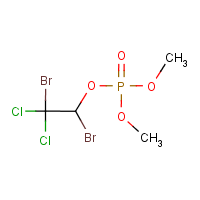Naled
Agent Name
Naled
Alternative Name
Dibrom
CAS Number
300-76-5
Formula
C4-H7-Br2-Cl2-O4-P
Major Category
Pesticides

Synonyms
1,2-Dibromo-2,2-dichloroethyl dimethyl phosphate; Alvora; Arthodibrom; BRP; Bromchlophos; Bromex; Bromex (insecticide); Bromex 50; Dibrom; Dibromfos; Dimethyl 1,2-dibromo-2,2-dichloroethyl phosphate; Ethanol, 1,2-dibromo-2,2-dichloro-, dimethyl phosphate; Flibol Ex; Fosbrom; Fosforan O-1,2-dwubromo-2,2-dwuchloroetylo-O,O-dwumetylowy [Polish]; Hibrom; Naledu [Polish]; Nikabrom; O,O-Dimethyl O-2,2-dichloro-1,2-dibromoethyl phosphate; O,O-Dimethyl-O-(1,2-dibrom-2,2-dichlor-aethyl)-phosphat [German]; O,O-Dimethyl-O-(1,2-dibromo-2,2-dichloroethyl)phosphate; O-(1,2-Dibrom-2,2-dichlor-aethyl)-O,O-dimethyl-phosphat [German]; O-(1,2-Dibromo-2,2-dicloro-etil)-O,O-dimetil-fosfato [Italian]; O-(1,2-Dibroom-2,2-dichloor-ethyl)-O,O-dimethyl-fosfaat [Dutch]; OMS 75; Ortho 4355; Ortho-dibrom; Orthodibromo; Phosphate de O,O-dimethyle et de O-(1,2-dibromo-2,2-dichlorethyle) [French]; Phosphoric acid, 1,2-dibromo-2,2-dichloroethyl dimethyl ester (8CI)(9CI); RE-4355; [ChemIDplus]
Category
Organophosphate Insecticides
Description
Colorless to white solid or straw-colored liquid (above 80 degrees F) with a slightly pungent odor. [insecticide]; [NIOSH]
Sources/Uses
Used to kill aphids, mites, mosquitoes, and flies; also used by veterinarians to treat worm infections in dogs; [EXTOXNET] Used as an insecticide and acaricide in field crops, greenhouses and mushroom cultivation; Also used to kill mosquitoes; [ACGIH]
Comments
Classified as "moderately toxic," naled has an LD50 of 91 to 430 mg/kg in rats; Skin sensitization has been reported; [EXTOXNET] Structurally similar to dichlorvos; A dermal sensitizer; [ACGIH] “The average of two baseline respective cholinesterase activity determinations three days apart, with no exposures to enzyme inhibiting pesticides for at least 30 days, is recommended for each worker prior to exposure to cholinesterase inhibitors because of large inter-individual differences in published baseline values. To be established at least once a year. Removal from workplace exposures is recommended until the cholinesterase activity returns to within 20% of baseline.” [TLVs and BEIs]
Reference Link #1
Biomedical References
Exposure Assessment
BEI
Acetylcholinesterase activity in red blood cells = 70% of individual's baseline; Butylcholinesterase activity in serum or plasma = 60% of individual's baseline; Sample at end of shift; [TLVs and BEIs]
Skin Designation (ACGIH)
Yes
TLV (ACGIH)
0.1 mg/m3, inhalable fraction and vapor
PEL (OSHA)
3 mg/m3
MAK
0.5 mg/m3, inhalable fraction
IDLH (NIOSH)
200 mg/m3
Excerpts from Documentation for IDLHs
Basis for original (SCP) IDLH: Because no useful data on acute inhalation toxicity are available, the chosen IDLH has been estimated from the male rat oral LD50 of 250 mg/kg [Gaines 1969 cited by ACGIH 1971]. ACGIH [1971] also reported that the acute toxicity data, inhalation data, and experience to date indicate that this is not a highly dangerous material. . . . Human data: None relevant for use in determining the revised IDLH.
Vapor Pressure
0.0002 mm Hg
Lethal Concentration
LC (mice) > 1,500 mg/m3/6h
Reference Link #2
Adverse Effects
Skin Sensitizer
Yes
ACGIH Carcinogen
Not Classifiable
Other Poison
Organophosphate
Diseases, Processes, and Activities Linked to This Agent
Diseases
Occupational diseases associated with exposure to this agent:
Processes
Industrial Processes with risk of exposure: